December 26, 2017 / by howard / 9,344 Comments / Filed under Blog, Media
Day 4 – Shira Huts – via Lava Tower (4640 m/15220 ft) – Barranco Huts (3985 m/13070 ft)
Walking distance: 9 km/5.6 miles
Walking time: 6-8 hours
Altitude gain: 135 m/440 ft (790 m/2590 ft to Lava Tower)
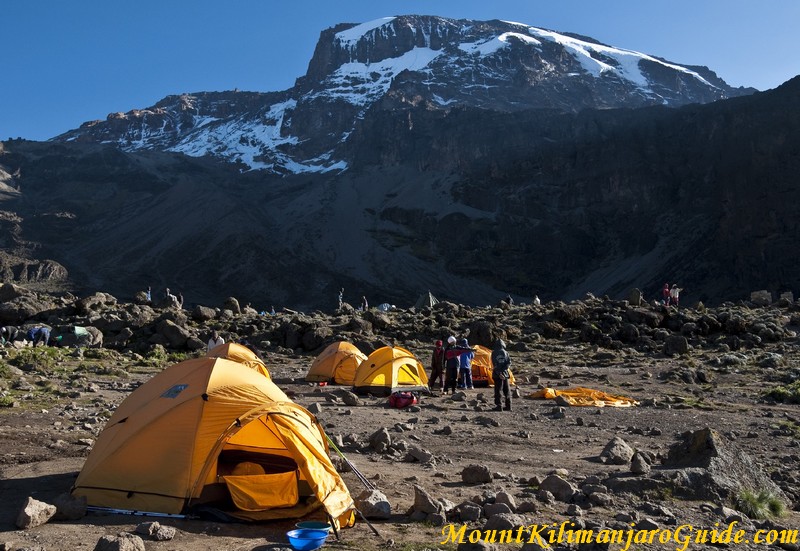
Since they camped at Shira Huts, the fourth day started with a good two and half hours of walking mostly gently uphill (and scrambling a bit for two short sections). Following the slope of the Lemosho Plateau they gradually left the heather and moorland behind and entered the mostly barren alpine desert region, enjoying breathtaking views all the way.
After some bends and ups and downs they reached the junction with the busy Machame Route. Shortly after that they came to another junction. At this point they headed towards the Lava Tower where they ate lunch.
The Lava Tower is a 100 m/300 ft volcanic plug, left over from times when Kilimanjaro was volcanic. The path towards it is a gentle slope and as they climbed towards it the short heather disappears altogether to reveal the rocky ground of the lava ridges.
The climb is often experienced as strenuous. After all, they’ve climbed up to over 4500 m and their bodies will surely notice the lack of oxygen!
After a much deserved lunch break near the Lava Tower they descended into the beautiful Barranco Valley, the result of a massive landslide some 100,000 years ago. The valley is sheltered by towering cliffs and is much greener. There is vegetation again, most notably the giant senecios and lobelias. They had great views across the plains way below and also got their first glimpse of the Barranco Wall which they will climb tomorrow…
The Barranco Camp is without a doubt the most spectacular campsite of this route, with fantastic views of Kibo, the Western Breach and the first of the southern glaciers, a fitting reward after a strenuous day. They have been quite high today, but by climbing high and sleeping low they are giving their bodies the best chances to adapt. This was an important day for acclimatization.
From this point onwards all climbers follow the same trail to the summit. They are actually planning on reaching the summit a day early! Everyone is still feeling fine physically and they are in good spirit. When I talk to them I hear a lot of laughter in the background. This time they are actually completing the whole Lemosho route as they are not doing the Western Breach. Their guide, Steve, told them that actually the last time he did the Western Breach was with them three years ago. With the glacier melting so rapidly, the Western Breach is very unsafe and therefore, it is rarely used anymore. It is estimated that within ten years there will no longer be snow on top of Mt. Kilimanjaro “the roof of Africa.”
When I spoke to them, they had just reached camp and were happy to be there. Max and Ben actually reached camp 40 minutes before Howard and Shayna. They are all ready to rest and sleep so they can continue tomorrow which is scheduled to be an exciting day as they traverse the Barranco Wall. Below are some images of the Barranco Wall. I think these photos illustrate exactly why I am not with them on this trip.
More tomorrow!
Anne
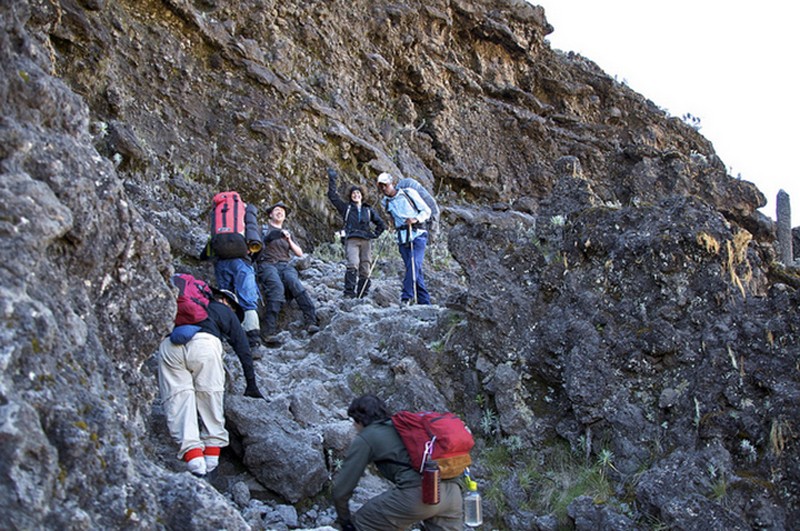
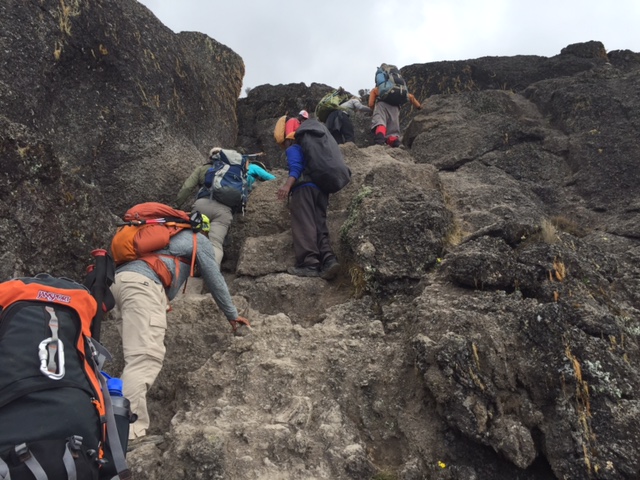

February 22, 2013 / by adam1 / 5,232 Comments / Filed under Media
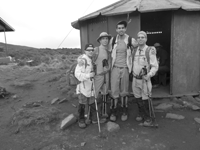 Things didn’t go exactly as planned during what a Chicago attorney and his two sons call Operation Climb MDA, but Howard Zavell says the boys nevertheless learned a valuable lesson: Things don’t always go exactly as planned.
Things didn’t go exactly as planned during what a Chicago attorney and his two sons call Operation Climb MDA, but Howard Zavell says the boys nevertheless learned a valuable lesson: Things don’t always go exactly as planned.
The adventure still raised close to $30,000 for Magen David Adom, Israel’s version of the Red Cross.
The plan, in the works for 18 months, was for Highland Park MDA supporter Zavell and his sons, Benjamin, 12, and Max, 15, to climb Mt. Kilimanjaro, Africa’s tallest peak, in December.
“Climbing Kilimanjaro was something I had wanted to do for a very long time, but it never seemed like the right time to do it,” Zavell said in a recent phone conversation. “I thought this would be a good time before I get much older and before everybody goes off to college.”
The Zavells are experienced climbers and high-altitude backpackers, and Howard Zavell says that Kilimanjaro, while one of the tallest mountains in the world, is not a difficult “technical climb.”
“It’s not as hard to climb as Everest,” he says. “On Kilimanjaro, your life is not in danger unless you do something stupid. For that kind of experience, it’s relatively safe.” He thought climbing it would be a natural progression for his boys from the outdoor activities they had enjoyed together.
“It’s a huge, magnificent mountain and a unique place that has so many different ecosystems you climb through,” he says. “You walk through rainforest, high alpine desert, lava flows, then areas like the arctic. You experience all that in one place, and I wanted to give my sons that opportunity and let them have that experience.”
The family, which also includes Zavell’s wife Anne, was already familiar with MDA since son Max participated in a program with the organization. He raised money for the service and, while in Israel for his bar mitzvah, visited an MDA emergency response station.
Howard Zavell enlisted a group of friends, created a website and Operation Climb MDA was formed. The Zavells paid all expenses for the trip themselves so all funds raised went directly to the organization, Zavell explains.
“I wanted to expose more people to MDA. I’m 45, and a lot of Jewish people in my age group don’t know much about it. It’s like, ‘that was my grandfather’s charity.’ Just to get exposure for it was part of our goal,” he says.
The trip itself was eventful, but not exactly in the way the climbers would have hoped. First, on the day before they were to summit, a cousin, James Milin, who was accompanying them, became ill at around 13,000 feet, developing dehydration and altitude sickness. Along with a guide, he descended, but the Zavells pressed on.
“We continued to climb, but the night before the summit, I was not feeling well,” Zavell says. “We had to take malaria pills, and I had felt poorly from the day I started taking them.” On this night, he was having chest pains and nausea. In addition, a blizzard was brewing.
“I had to make a very difficult decision,” he says. “It crossed my mind that if you have a heart attack, you are not getting off this mountain” since above 12,000 feet there is no ranger station nor any chance for medical help. Zavell decided that it was necessary to descend.
A pair of guides offered to continue to the summit with the boys, “but I promised my wife I wouldn’t separate from them,” Zavell says. “So at 9 at night, we broke camp and walked into a blizzard down the mountain.” They had to walk for more than four hours to reach a waiting emergency vehicle, then several more hours to get to a hospital. There physicians told Zavell that his symptoms were from the malaria pills.
“I was perplexed and annoyed,” he says. “It was not a highlight. We had prepared for this for 18 months. My sons were very happy I was OK but it was a huge letdown for all of us, a real emotional low. In retrospect, though, it was the right thing to do with the information we had.”
After the initial disappointment, Zavell says he realized the adventure was still a valuable experience for all three of them.
“It was a good life lesson that things don’t always go the way you want,” he says. “And it was really about this journey together, preparing for it and working together.” They raised nearly $30,000 for MDA as well. (Supporters can still donate to Operation Climb MDA at www.opclimbmda.com or on its Facebook page.)
Now, Zavell says they are considering trying again, probably next December, considered the best time to climb the mountain.
What does Anne Zavell think of the plan?
“She is definitely outside of her comfort zone, but she was our number one supporter,” Zavell says of his wife of 19 years. “It’s not something she would ever want to do but she sees how good these kinds of activities are for the boys, how much confidence it gives them. She recognizes it is an opportunity to continue to instill the values of being prepared, working hard for a goal, standing for something and doing your best.”
Zavell says that he, in turn, was impressed with the trust his wife placed in him. “Was she nervous? Yes. Communication wasn’t great, but she trusted me that I wouldn’t split up from the boys and wouldn’t take any risks. If I felt danger I would take a cautious route, and that’s what I did,” he says. “The first thing she said to me was, so when are you boys going back? That’s an incredible statement.”
The family will be in Israel again in June for Ben’s bar mitzvah and plan to “build momentum” for a future trip, Zavell says. “My feeling is, if we didn’t get to the summit because I just couldn’t do it, I could probably walk away from it easier. But the way it happened, it leaves a taste of unfinished business.”
And this time, he’ll probably skip the malaria pills.
Chicago Jewish News 2/22/2013
http://chicagojewishnews.com/story.htm?sid=5&id=255834
January 1, 2013 / by adam1 / Make A Comment / Filed under Media
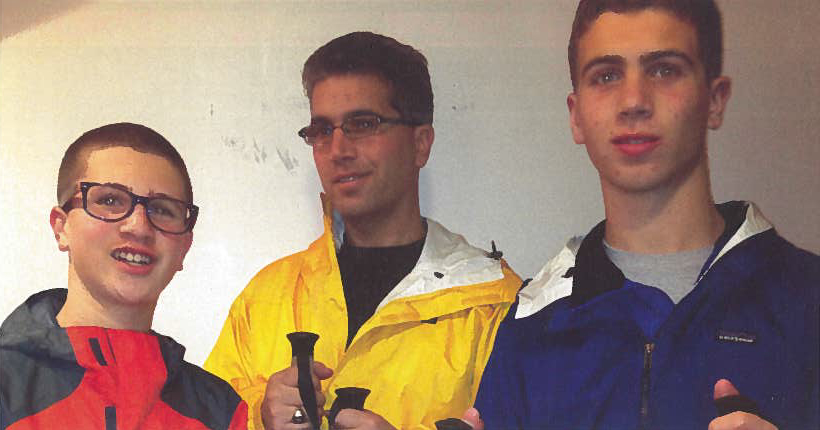
Credit Chicago Athlete
Howard Zavell had long wanted to climb Mount Kilimanjaro, bur he got busy instead with raising a family. As his sons got older, he began to dream of climbing the mountain with them. At first, his wife, Anne, had some legitimate concerns about her husband raking their sons halfway around the world to climb an almost four mile tall mountain in Africa. At the time, Benjamin was only 11 and Max was 13. Bur after learning more about it, both agreed that it would be a tremendous opportunity for them.
At first the boys had some reservations about the challenge. Max had recently heard a story about a climbing disaster on Mount Everest and was apprehensive about the risks. Although both boys were active in sports and Boy Scours, they wanted to know more about the climb before they committed.
Howard called on a trusted former gymnastics coach, Seymour Rifkind, for help with the decision. Rifkind had climbed Kilimanjaro twenty years earlier. He met with the boys and evaluated their readiness for facing the challenges of climbing the 19,341-foor mountain. After hearing about their extensive experiences with camping, Boy Scouts and sports, he agreed that they were ready. He explained that unlike Everest, climbing Kilimanjaro was non-technical-much like a very long trail hike at altitude. It was August 2011, and the boys were now enthusiastic about taking on the Kilimanjaro challenge.
Then, they began a year and a half of hard work. Both , the boys and their dad had to get in the best shape of their lives. They starred with a strength and conditioning program. Then they found an area of steep wooded bluffs and ravines in Lake Forest lined with trails and stairways. At first, they would walk up and down the stairs a few times. After a while, they were able to run up the stairs. Gradually, they became fit enough to run up and down the stairs and hills with backpacks for a sustained period of time. They also incorporated longer hikes with packs as part of the training.
“The boys are both in really great shape,” Howard says. “I had more work to do to get as fit as they did.” Both boys play soccer, Max is a sprinter and Ben is learning to be a slider in luge and has been invited to Lake Placid to participate in a USA luge training camp this winter.
“I see the focus in their eyes,” Howard says. “They are enjoying this because we are doing it together. They are confident and sure of themselves. The boys have learned the value of setting high goals and working hard for a long time to achieve them.” Along the way, the Zavells are strengthening family bonds.
Max is now 15 and is a freshman at Highland Park High School. Benjamin is 12 and a seventh grader at Northwood Junior High School. They are scheduled to begin climbing on Dec. 18. They will be on the mountain for nine days and will hike roughly 65 miles. You can follow their climb at www.opclimbmda.com and learn more about their fundraising effort for MDA, Magen David Adorn, a non-partisan emergency service for injured in Israel.
Chicago Athlete: Chris Palmquist January 2013
http://mychicagoathlete.com
zp8497586rq
December 9, 2012 / by adam1 / 7,433 Comments / Filed under Media

Click on image to read.
The North Shore Weekend Dec 9, 2012
http://issuu.com/jwcmedia/docs/issue9/8
November 26, 2012 / by adam1 / Make A Comment / Filed under Media
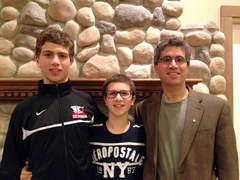
HIGHLAND PARK — Highland Park resident Howard Zavell plans to climb Africa’s highest mountain, Mt. Kilimanjaro, in December with his sons Max, 15, and Ben, 12. They are using the climb as a chance to share an exhilarating adventure while raising money and awareness for Magen David Odom, the emergency services system in Israel. Information is available at www.opclimbmda.com.
Q. Why Mt. Kilimanjaro and why now?
A. While the climb takes you to 19,336 feet, it is not a technical climb. So you have the ability to experience a high-altitude climb, without the technical requirements that are usually associated with a high mountain experience. I have always thought that it would be a good physical challenge, but having my sons experience this with me has given it an entirely new meaning.
Q. I understand you first had some “push back” about taking your sons along. What convinced everyone that this is a good idea?
A. After talking with an old friend who had climbed Kilimanjaro, I realized that it was realistic to climb with my sons. My sons camp a lot, including in the winter. Having shared many outdoor experiences together, I felt confident that this was an adventure for which they could prepare.
Q. You’ve spent the last year in training for the expedition. What was your regimen?
A. Once we decided we were going to climb Kili, we started a stair climbing and hiking regimen. Mostly, we used the stair case at the Openlands in Fort Sheridan. We started with walking these, then running them, and then running up and down them while wearing a backpack. It was a terrific place to train, except we had a few wasp attacks during the summer.
Q. Why did you choose to raise money for Magen David Odom?
A. MDA is basically the Israeli Red Cross. It runs all of the ambulance and emergency services in Israel. It supplies 95 percent of the blood in Israel to the civilian population and 100 percent to the Israeli Defense Forces. MDA will help whomever needs it, without a question about race or religion. Today, MDA is even more important with the recent attacks and violence. No matter how you feel politically and emotionally about the situation, as a human being, you realize that the work which MDA does in Israel saves lives.
Q. What do you hope your sons will take away from the climbing experience?
A. My wife and I want our children to continue to learn that hard work and preparation are the keys to success, whether the task at hand is a physical adventure, a charitable act, an academic event or a business pursuit. By raising money for MDA, we’re teaching the importance of participating in causes beyond ourselves.
BY KAREN BERKOWITZ | kberkowitz@pioneerlocal.com November 26, 2012 8:46AM
http://highlandpark.suntimes.com/news/community/16411324-418/highland-park-dad-sons-to-climb-kilimanjaro.html
June 18, 2012 / by adam1 / 8,045 Comments / Filed under Media

Credit American Friends of Magen David Adom
MDA, (Magen David Adom) Israel’s first-aid and disaster relief organization, proudly emblematized by the Red Star of David, plays a pivotal role saving lives in Israel regardless of race, religion or political affiliation during times of both war and peace. This humanitarian organization is much like the American Red Cross and 911 emergency services. When you dial 101 in Israel, these medical teams will perform lifesaving procedures such as opening the trachea in the case of a breathing obstruction before patients arrive at the hospital, caring for such medical conditions as heart attacks, strokes, road accidents, pregnancies, those injured by terrorist attacks and more.
With a current fleet of 800 ambulances (some armored), operating from 123 Emergency Medical Stations throughout Israel, and 16 MDA Stations in West Bank communities, MDA carries a colossal responsibility for its nation and those near it.
First established in 1930 by a nurse named Karen Tenebaum as a result of the Arab riots in 1929 that attacked Jewish farming and urban settlements, Magen David Adom has provided vital medical support to the public for all pre-hospital emergency needs such as medical, disaster, ambulance and blood services for over eighty years via its team of professionals and volunteers. Adhering to the Hebrew word, Arevut, the responsibility ‘to care for other people, the same way we care about ourselves’, MDA today has over 13,000 volunteers dedicating themselves to aid all those in need of immediate medical care. Their humanitarian efforts extend beyond the borders of Israel, helping those international communities victimized by environmental disasters such as Haiti, Japan and New Orleans.
About ten years after MDA was founded, a group of Americans aligned together, also practicingArevut and founded the American Red Magen David for Palestine, now called American Friends of Magen David Adom (AFMDA) which is the sole U.S. fundraising arm of MDA year-round. During World War II, American supporters shipped over the much needed ambulances and blood collection vans and in 1950 when MDA was officially declared as Israel’s National Red Cross Society, AFMDA spearheaded fundraising campaigns to raise the monies necessary for MDA to continue its lifesaving efforts.
In the early 1980’s, AFMDA raised over $32 million in funds to build a National Blood Services Center for MDA which supplies 100% of the Israeli Defense Forces blood needs and 95% of the blood needed for hospitals and also houses Israel’s Cord Blood Bank which is the platform for much of Israel’s stem cell research. They receive 1200-1400 units of blood per day which is then separated into parts to treat various health issues. In addition to locals donating blood, American Friends of Magen David Adom have organized blood drives for tourists visiting Israel, often setting them up in hotels during peak holidays as there is often a shortage during this time. In 2007, over 800 tourists donated blood. Although the AFMDA no longer holds blood drives in Israel, tourists can visit any MDA station and donate blood if they wish.
In the last five years, during times of extreme vulnerability, AFMDA rolled out massive emergency fundraising campaigns to ensure MDA had all the tools it needed to serve its nation’s emergency healthcare needs.
In 2006, when Israel was attacked by Hezbolla rockets (The Lebanon War) destroying many of MDA’s needed medical supplies and ambulances, AFMDA declared a Code Red relentlessly raising funds to replenish MDA with the necessary resources for its survival. MDA received approximately 47 ambulances: 36 standard (Basic Life Support) ambulances, 10 Mobile Intensive Care Units (MICUs) and one armored ambulance.
In 2009, AFMDA declared another Code Red during the Gaza War when Israeli communities were struck with rockets, renovating MDA stations which had been under attack, building crucial emergency stations and generating funds to nourish MDA with other medical resources.
For 72 years, during times of war and peace, AFMDA has been a strong ally for the humanitarian efforts of MDA which currently cares for approximately 600,000 patients annually.
Since its inception, the AMFDA has generated solidarity from all those that desire to help save lives in Israel. For some it is a religious calling while for others it is an emotional, cultural or spiritual connection to the country and its humanitarian efforts.
There are AFMDA chapters all over the United States and while no Code Red has been declared, in these uncertain times AFMDA is accelerating its fundraising efforts to ensure that MDA is prepared for more routine emergencies, like car accidents and heart attacks, and that it will be prepared if any attacks should occur.
In the Midwest:
Currently:
A group of people, in the Chicago land area, are raising funds for AFMDA via an ambitious adventure of climbing Mt. Kilimanjaro, a 19,336 foot mountain in Africa: Operation Climb.
The Great Vest Side Men’s Group, an organization originally created as a social gathering for those growing up on the West Side of Chicago circa 1930-1960 has also blossomed into a fundraising arm for charities, AFMDA in particular. They are currently raising funds for their 8th ambulance (approximate cost: $100,000) and a second pediatric dialysis machine for the Shaare Zedek Medical Center in Jerusalem. (approximate cost:$25,000) The word, “Vest” in the organization’s name was a tribute to many of the member’s immigrant Jewish parents’ accents.
For more info on AFMDA in the Midwest Region:
Contact Midwest Regional Director: Sandy Rosen (888-674-4871)
In the West:
In Los Angeles, 13 year old Robert Leeds raised money to purchase two ambulances for MDA in lieu of gifts for his bar-mitzvah, setting an extraordinary example for his peers.
Currently, in the West:
On July 9th, Magen David Synagogue in Beverly Hills is holding an event to raise funds for an ambulance. The event will be hosted at a congregant’s home and the ambulance will be funded by donations from synagogue members.
On July 14th, Pacific Palisades resident Vivian Feintech will be hosting a 60th birthday party, but in lieu of gifts, she will be asking friends and family for donations toward an ambulance. Impacted by a recent visit to the Israeli town of Sderot, which has been a target of bombs from Gaza, she was inspired to fundraise for AMFDA.
For more info on AFMDA in the Western Region:
Contact Western Regional Director: Yossi Mentz (800) 323-2371
In the Northeast:
Recently, NYC Mayor Bloomberg donated the new MDA station in Jerusalem named after his father, recognizing MDA’s spirit of philanthropy.
For more info on AFMDA in the Northeast Region:
Contact Northeastern Regional Director: Gary Perl (866) 632-2763
Over the last four years, AFMDA has raised over $100 million dollars providing emergency vehicles, blood mobiles, renovations to MDA stations, medical supplies, administrative training and infrastructure to the MDA National Blood Services Center. Its valorous deeds will continue and will
Highland park Patch by LG Taylor June 18, 2012 at 5:04 pm
http://highlandpark.patch.com/blog_posts/american-friends-of-magen-david-adom-afmda-helping-save-lives-in-israel-909ab46c







 Things didn’t go exactly as planned during what a Chicago attorney and his two sons call Operation Climb MDA, but Howard Zavell says the boys nevertheless learned a valuable lesson: Things don’t always go exactly as planned.
Things didn’t go exactly as planned during what a Chicago attorney and his two sons call Operation Climb MDA, but Howard Zavell says the boys nevertheless learned a valuable lesson: Things don’t always go exactly as planned.


